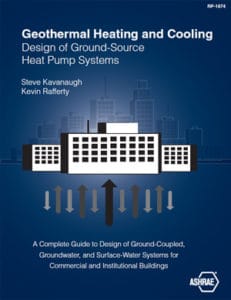Geothermal Heating and Cooling Design of Ground-Source Heat Pump Systems
Geothermal Heating and Cooling Design of Ground-Source Heat Pump Systems
Geothermal Heating and Cooling Design of Ground-Source Heat Pump Systems is an all-inclusive term for a variety of systems that use the ground, groundwater, or surface water as a heat source and sink. GSHPs are subdivided by the type of exterior heat exchange system. This includes ground-coupled heat pumps (GCHPs) that are closed-loop piping systems buried in the ground, groundwater heat pumps (GWHPs) that are open-loop piping systems with water wells, and surface- water heat pumps (SWHPs) that are closed-loop piping coils or open-loop systems connected to lakes, streams, or other reservoirs. Heat pumps are located in the buildings and cool by removing indoor heat and rejecting it to the exterior GSHP loop. In heating, the process is reversed as heat is removed from the outdoor loop by the heat pumps and is delivered to the building.
You can also read Combined Heat and Power Design Guide
Geothermal Heating and Cooling Design of Ground-Source Heat Pump Systems Content
- Preface
![]()
- Acknowledgments
- Symbols, Acronyms, and Abbreviations
- Introduction to Ground-Source Heat Pumps
- Equipment for Ground-Source Applications
- Fundamentals of Vertical Ground Heat Exchanger Design
- Applied Ground-Coupled Heat Pump System Design
- Surface-Water Heat Pumps
- Piping and Pumps for Closed-Loop Ground-Source Heat Pumps
- Hydrology, Water Wells, and Site Evaluation
- Groundwater Heat Pump System Design
- GSHP Performance and Installation Cost
- A:Conversion Factors
- B:Standards and Recommendations for GSHP Components and Procedures
- C:Pressure Ratings and Collapse Depths for Thermoplastic Pipe
- D:Vertical-Loop Installation Equipment and Procedures
- E:Example of Field Study Results
- F:Properties of Antifreeze Solutions
- G:Volumes of Liquids in Pipe
- H:High-Density Polyethylene and Polypropylene Pipe Fusion Methods
- I:Determination and Impact of Ground Coil Flow Imbalance
- L:Well Flow Test and Water Chemistry Analysis Specification
- M:Example Well Chemical and Biological Analysis Results
- N:Well Problems and Strategies to Avoid Them
- O:Heat Exchanger Temperature Prediction Spreadsheet
The primary audience includes HVAC design engineers, design build contractors, GSHP subcontractors, and energy/construction managers of building owners. A unique feature of interest for building owners and architects is that the book provides characteristics of quality engineering firms and information that should be provided by design firms competing for GSHP projects.
Download
Geothermal Heating and Cooling Design of Ground-Source Heat Pump Systems
Geothermal Heating and Cooling Design of Ground-Source Heat Pump Systems


Comments are closed.